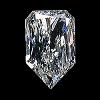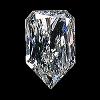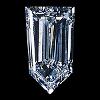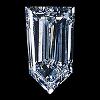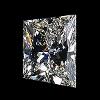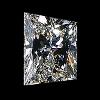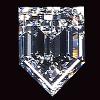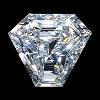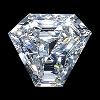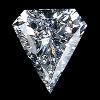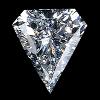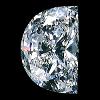Round Brilliant

Cushion Cut

Princess Cut

Asscher Cut

Heart Shape

Oval Cut

Pear Shape

Emerald Cut

Trilliant Cut

Marquise Cut
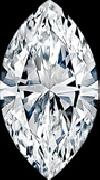
OUR SITE IS FOR INFORMATION
Making Nash Jewelry your first choice for diamonds will eliminate any and all uncertainty about the quality of the diamonds you buy.
The 4 C's
1. Cut: A diamonds shape also plays an important role and often affects how much sparkle it displays. Round shapes possess the most brilliance. Marquise, Pear, Princess, Radiant, and Emerald cuts are very elegant and also possess great fire. Cut is sometimes not discussed by certain jewelers because it requires academic mastery of the topic and the sincerity to convey an accurate description of a fine diamond. With all of its other characteristics equal, a poorly cut diamond does not look as good and is tremendously less valuable than a well-cut diamond. You might pay less for a poorly cut diamond, but the diamond will always be esthetically inferior. With all the other characteristics equal, the value of a well-cut diamond is much greater than that of a poorly cut diamond. Nash Jewelry sells only well-cut diamonds and stresses the importance of getting the best value, for the best diamond.
2. Color: The word color brings to mind bold, vivid images, but when used in regard to diamonds, the meaning is quite the opposite. The most sought after diamond is actually referred to as colorless. Diamonds range in color from colorless to yellow. There are also fancy color diamonds that are highly sought after such as pinks, Canary yellows and blues. These are extremely rare and can be quite expensive. The following is the G.I.A. grading system standard for diamond color: Grade D, E, F: Colorless Also know as Fine White or River White. This diamond color is the finest and rarest. Grade G, H, I, J: Near Colorless. Known also as White. Experts sometimes find them hard to distinguish from Colorless when they're set. They're truly an excellent value choice. Grade K, L, M: Faint: Yellow Referred to as Top Silver, these diamonds have a yellow tinge and are more common. Grade M, N, O, P, Q, R: Very Light Yellow Grade S-Z: Light Yellow Even though you may not be able to see the almost imperceptible letter grade distinctions between colorless and neat colorless, or one or two letter grades of tints, by buying a diamond with G.I.A. Certification, you are guaranteed the certainty of it's quality. 3. Clarity: Unseen by the naked eye, a diamond's landscape and true characteristics are revealed when the diamond is viewed under a jeweler's microscope or loupe. Within this miniature landscape of unique and natural occurrences, there are tiny specks, ripples and indentations embedded in the crystal, which identify your diamond much like a fingerprint. These imperfections are known as inclusions, and the degree to which a diamond is free from them determines the clarity and value of the gem. The clarity scale is broken down into the following grades: F: Flawless Free from all inclusions or blemishes. IF: Internally Flawless No inclusions visible at 10x magnification. VVS1: Very Very Small Inclusion 1 Inclusions that are extremely difficult to locate at 10x. VVS2: Very Very Small Inclusion 2 Inclusions that are very difficult to locate at 10x. VS1: Very Small Inclusion 1 Minor inclusions that are difficult to locate at 10x. VS2: Very Small Inclusion 2 Minor inclusions that are somewhat difficult to locate at 10x. SI1: Small Inclusion 1 Noticeable inclusions that are easy to locate at 10x. SI2: Small Inclusion 2 Noticeable inclusions that are very easy to locate at 10x. Some inclusions may be seen with the unaided eye. I1: Included 1 Obvious inclusions. Somewhat easy to locate with the unaided eye. I2: Included 2 Obvious inclusions. Easy to locate with the unaided eye. I3: Included 3 Obvious inclusions. Very easy to locate with the unaided eye. The above clarity grading scheme is in accordance with the GIA (Gemological Institute of America) . 4. Carat: Carat is the unit of weight for diamonds. Diamonds under one carat weight are discussed in terms of "points" - with 100 pints equal to one carat. A stone weighing 75 points weighs 75/100 of a carat, or 3/4 carat; a 25 point stone is 1/4 carat; a 10 pint stone is 1/10 carat. Knowing the "per carat cost" will allow you to know the actual diamond price. In pricing, there's a great difference between one carat total weight verses the weight of one stone (1 ct). For example, a one carat diamond is much more valuable and much more expensive than a grouping of several smaller diamonds which when combined, add up to one carat in total weight. G.I.A. Certification The G.I.A.-Gemological Institute of America was established to provide universal grading systems and accurate, indispensable information for the entire jewelry industry. It has become the hallmark of reliability and the indicator of integrity. Known and respected G.I.A. Gem Trade laboratories issue a diamond grading report. This report provides great details on the diamond and offers a diagram of internal and external characteristics or flaws. It is the fingerprint that uniquely identifies that particular diamond and which could be used later to verify that diamond. Because G.I.A. grades only natural diamonds, those who purchase diamonds with a G.I.A. Diamond Grading Report will be assured that their diamond will not be a synthetic (man-made) or clarity enhanced (fractured filled) diamond. These are the prevalent problems facing the consumer in this high-tech era. Clarity enhanced diamonds will not be awarded a G.I.A. report simply because clarity enhancement involves the filling of extremely poor quality diamonds with polymers to improve their appearance. This is a reversible chemical process that usually involves diamonds that are classified below G.I.A.'s lowest clarity rating 13. Diamond Care Even though the diamond is the hardest material known to man, it is not the toughest. When subjected to substantial mechanical stress it can be damaged. Therefore it is wise not to wear the diamond ring when involved in activities that are physically rigorous. Always take out adequate but not excessive insurance coverage on the ring. The key to cleaning the diamond's smooth hard surface is to remove the grease and skin oils it attracts. Warm water, grain alcohol or ammonia can be used with a soft brush. Diamonds can scratch anything including each other, so store them in velvet compartments separate from other precious gems or delicate jewelry. If this is an engagement ring, take care that the prongs of the setting remain secure by checking them carefully after each cleaning.
Matched Pairs
